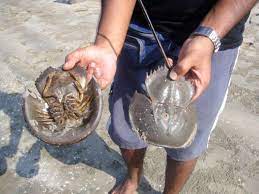Horseshoe Crabs:

Scientists have recently urged the Odisha government to immediately come up with a robust protection mechanism before the Horseshoe crabs (living fossil) becomes extinct due to destructive fishing practices.
- The horseshoe crab is a marine chelicerate arthropod living in shallow coastal waters on soft sandy or muddy bottoms and spawns mostly on intertidal beaches at summer-spring high tides.
- The Chelicerata is a division within the Arthropoda, containing animals such as spiders, scorpions, harvestmen, mites and ticks.
- Like all arthropods, they have a segmented body and segmented limbs and a thick chitinous cuticle called an exoskeleton.
- It is known as a marine ‘living fossil’.
- Odisha is the largest habitat of horseshoe crabs in India.
- Conservation status in India:
- Wildlife Protection Act 1972: Schedule IV
- IUCN Status
- American horseshoe crab: Vulnerable
- Tri-spine horseshoe crab: Endangered




